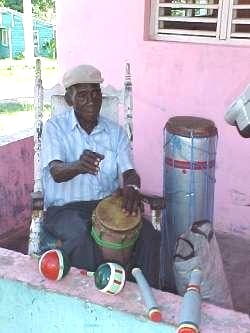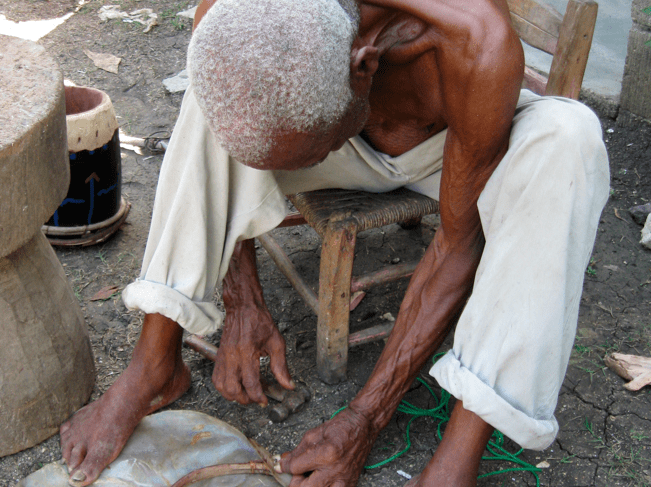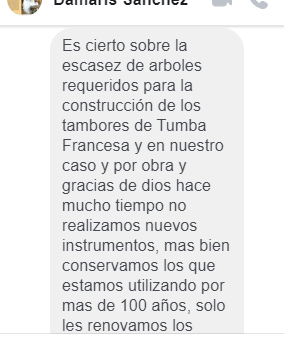By Heather Sloan, on behalf of Heather Sloan and co-researcher Professor Edis Sánchez Rosario
One day long ago while I was living in the Dominican Republic, my percussion mentor, Edis Sánchez, took me to the home of a gentleman named Sixto Minier, who was the head of a group called Los Congos de Villa Mella. Los Congos is a brotherhood (cofradía) around which this particular community centers its social and spiritual practices, including performing music for burials and other activities meant to honor the deceased. At that time, Villa Mella seemed a long, long way from the center of Santo Domingo, the capital city on whose northeast edge it was perched. We visited Sixto Minier in part to look at the drums in his home. He was the leader of Los Congos at that time, and his mastery of the group's centuries-old drum-building techniques was unmatched. As we sat in his home, drums hanging from the ceiling beams, Mr. Minier asked me if I wanted some honey. In addition to his other talents, Don Sixto was an experienced beekeeper. When I said yes, he brought over an enamel pitcher, gently reached out to turn my palm face up, and poured the honey right into my cupped hand. I tasted the bees' lovely concoction, made from pollen collected at nearby bushes and flowering trees, and wandered to the open front door of the small house. There were a few chickens wandering around, and I think a dog or two, maybe a goat? It was hot, but there was shade from the surrounding woods. I remember looking at the trees and thinking how different they were from the oaks and redwoods in my home state of California. In the intervening years, Villa Mella has become much more urbanized, connected to central Santo Domingo by the city's rapid transit system, and that cool forest surrounding Sixto's house has retreated.
Don Sixto Minier. Leader of Los Congos de Villa Mella. La Comunidad de Mata de los Indios y su importancia Cultural. 7 February 2020. |
Domitilio Minier, brother of Sixto Minier, building a drum. Photo Credit: Edis Sánchez. Used with permission. |
Making a drum by hand is hard work. It takes strength, patience, knowledge of materials, and special tools and skills. Most drum-builders I have met from Afro-Caribbean traditions learned their craft at a young age, at the knee of a father or uncle (drumming and drum-building have largely been a male activity in the Caribbean, though this is slowly changing). Most also play the drums in addition to building them, or did if they are no longer able. As practitioners of longstanding traditions, skills, and artistry, they embody information important to their communities. And they must also interpret that information within the context of changing social, economic, and environmental circumstances. Throughout the Caribbean, many of the forest resources used to make drums have become scarce. My HASTAC Fellowship year was spent gathering data about that scarcity in order to understand how and whether drum-builders' relationship to the forest, and to specific tree species, has changed along with the availability of materials. The basic outline of the project, taken from my initial HASTAC application, is below:
For this project, I will construct an Esri Story Map to explore deforestation and Afro-Caribbean drum-making traditions in Cuba, Puerto Rico, and Hispaniola (Haiti/Dominican Republic). A number of drum-making traditions on these islands are threatened due to deforestation and urbanization. The story map will allow me to share information multimodally about cultural space, the environment, and sociopolitical factors as they pertain to the region's drum-making traditions. In addition to geospatial data about drum makers and the location of their source materials, the story map will contain prose, oral history excerpts, photos, and video recordings that describe the central importance of drums, and the trees from which they are made, to Afro-Caribbean spiritual communities on these islands. I have already gathered much of the project material on fieldwork trips to the region, most recently in 2016. Data already gathered includes interviews, photos, video, field notes, and primary source research. From these, I will create profiles and summary information for each country/territory. I will also include comparative data about deforestation in the four research sites using available data sets, data visualization, and digital mapping tools. To facilitate greater accessibility, I plan to include information in English and Spanish. My hope is that a comparison across national boundaries will clarify both regional challenges and strategies for preservation. The project could also be more broadly relevant as an example of interdisciplinary digital scholarship that employs digital mapping, data visualization, and audio-visual material in the service of arts and environmental advocacy. (See full proposal here.)

It is always a little tricky to plan out how much work one can do over a longish span of time. How sure can you be of online interview dates when your distant collaborators have to rely on multiple modes of transportation? When they understandably need to prioritize their busy work and family schedules over participation? What parts of the project will you want to avoid, and exactly how much procrastination time will that cost? From early on, I had narrowed the scope of the project and added in what I thought was a reasonable amount of extra time for the unknowns. I continued to refine both the tasks and the timeline as I got a better handle on where my energies needed to be focused.
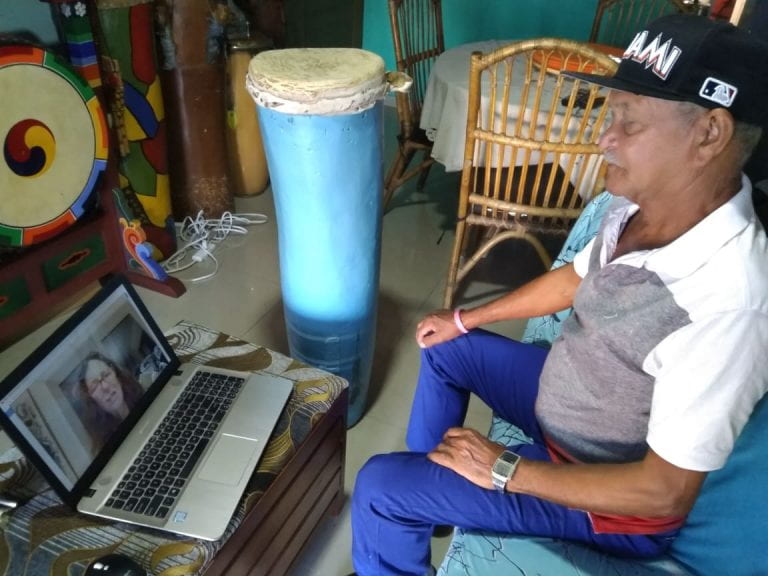
After the winter holidays were over, I had settled into a nice work rhythm, gathering data, increasing my comfort level with ArcGIS and StoryMaps, and conducting interviews and making new contacts. Connecting with drum-makers, musicians, dancers, and scholars from the Spanish-speaking Caribbean and Haiti was enlivening the work considerably, and it was getting exciting. By early February, I thought I was in good shape and had planned pretty well. I had not, however, planned for a global pandemic. That event quickly ground the project to a screeching halt as my attention turned to creatively reconfiguring my job, the jobs of student staff, and my children's school lives. But since this project covered one relatively small segment of a research trajectory that has spanned decades, I consider the work merely delayed, not lost. Given the immense suffering being visited upon people around the globe, I feel extremely fortunate that my own troubles amount to nothing more than minor inconvenience.
In terms of the basic components of the project, I hope to secure additional interviews and finish swipe maps showing past and recent forest-cover levels for each of the three islands-Cuba, Puerto Rico, and Hispaniola (Dominican Republic/Haiti)-only the map for Cuba is complete. I have translated some quotes and video clips but want to do more of those as well, so that I have options in the final layout of the StoryMap. But rather than belabor the matter with an exhaustive list of what boxes I did and did not check, I prefer to briefly touch on some of the compelling insights that have been shared with me during this process.
From Cuba: Tumba Francesa is a Cuban folkloric tradition with strong roots in the music and dance of neighboring Haiti as a result of migration to Eastern Cuba at the time of the Haitian Revolution. The drums used in Tumba Francesa are very large, made from single trees that must consequently be large in diameter themselves. Señora Damaris Sanchez Limonta is a core member of La Tumba Francesa Pompadour Santa Catalina de Riccis in Guantánamo. When I told Señora Sanchez Limonta I had heard it was difficult to find trees of the requisite size for building new Tumba Francesadrums, she replied that in her group, they simply do not make new drums:
Excerpt of a Facebook exchange with Damaris Sanchez, member of the Cuban ensemble La Tumba Francesa Pompadour-Santa Catalina de Ricci de Guantánamo. See English translation of full quote at right. | Ms. Sanchez' full Facebook message in English: "It is true that the trees required to build the drums for Tumba Francesa are scarce, and in our case, and thanks to God, we have not built new instruments for a long time; instead, we maintain the ones we have been using for more than 100 years, we just renovate the skins and ropes but maintain the authenticity." (translation mine) For me personally, the idea that the same drums have had generations of hands on them, and been part of decades of music, dance, and spiritual rejuvenation for this community, makes them very special indeed. |
From Puerto Rico: This island's forest history is complex. From catastrophic over-harvesting in the early 20th century, to a successful and sustainable mid-century reforestation program, to the recent devastation wrought by Hurricanes Irma and Maria, the forests, and those who depend on them for drum-making resources, have had many ups and downs. Many fallen hardwood trees had been earmarked for constructive repurposing post-Maria; however, the government abandoned that plan and left the valuable trees for waste. But thanks to small-business efforts by groups such as Puerto Rican Hardwoods as well as tree salvage advocacy efforts, many artisans are making excellent and creative use of the downed trees.I have not yet established a working relationship with a drum-builder in Puerto Rico, but I predict that when I do, I will find similar wood-rescue efforts taking place.
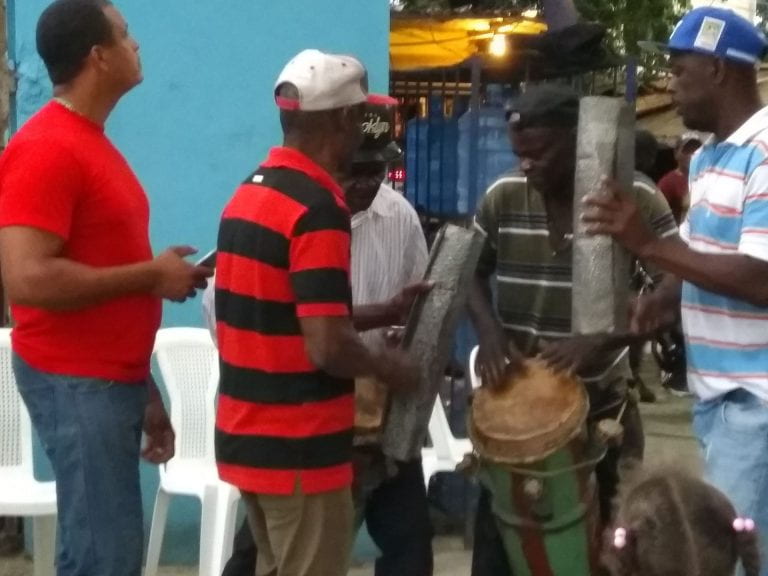
From the Dominican Republic: This is truly a labor of love for myself and my Dominican co-researcher, Edis Sánchez. Edis began his study of Caribbean folkloric music and drumming styles upon entering the children's Ballet Folklórico in the Dominican Republic at a young age, and it has been his specialization as a performer and researcher ever since. This project, and my longer-term research, would not have happened without him, period. One fact that has surprised me in our current work is that, despite a scarcity of suitable trees, none of the Dominican drum-builders interviewed so far has moved to PVC as an alternative for constructing drums. We do know that PVC is being used (and I personally own a PVC drum made by a member of the Minier family of Los Congos de Villa Mella). But it appears that the practice is being adopted more readily by younger drum-makers. Once we can resume research, it will be important to include the perspective of those who have made the switch to PVC, if we are to understand how use of different materials may change the experience of building, and playing, traditional drums of Afro-Caribbean origin.
Click here for a list of the interview questions used (in Spanish only).


